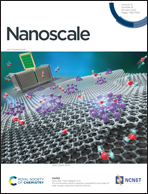Ligand-free template-assisted synthesis of stable perovskite nanocrystals with near-unity photoluminescence quantum yield within the pores of vaterite spheres†
Abstract
Ligand-free methods for the synthesis of halide perovskite nanocrystals are of great interest because of their excellent performance in optoelectronics and photonics. In addition, template-assisted synthesis methods have become a powerful tool for the fabrication of environmentally stable and bright nanocrystals. Here we develop a novel approach for the facile ligand-free template-assisted fabrication of perovskite nanocrystals with a near-unity absolute quantum yield, which involves CaCO3 vaterite micro- and submicrospheres as templates. We show that the optical properties of the obtained nanocrystals are affected not mainly by the template morphology, but strongly depend on the concentration of precursor solutions, anion and cation ratio, as well as on adding defect-passivating rare-earth dopants. The optimized samples are further tested as infrared radiation visualizers exhibiting promising characteristics comparable to those that are commercially available.



 Please wait while we load your content...
Please wait while we load your content...